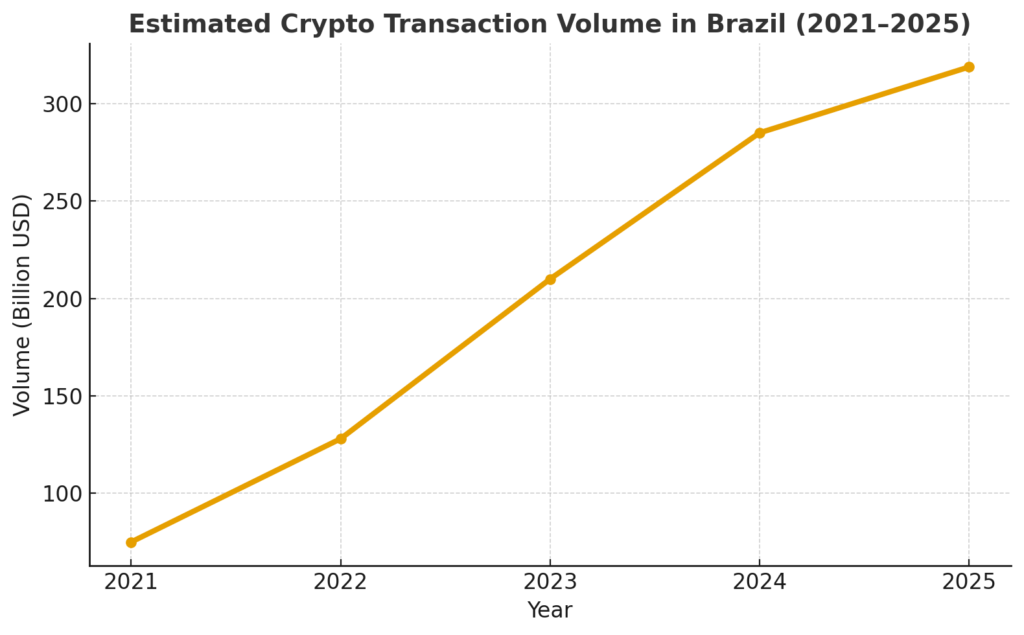
Key Takeaways :
- Brazil’s central bank, Central Bank of Brazil (BCB), has unveiled sweeping regulations for virtual asset service providers (VASPs), introducing a formal licensing regime, enhanced AML/CFT controls, governance standards and capital requirements.
- Crypto-to-fiat and fiat-to-crypto transactions (especially involving stablecoins) will now be treated as foreign exchange (FX) operations under Brazil’s external-capital control framework.
- Cross-border transfers and dealings with non-authorised entities face a cap (≈ US$100,000) per transaction, and full compliance is required by February 2, 2026, with a final deadline for operations under authorisation by November 2026.
- The moves aim to curb illicit uses of stablecoins and unregulated crypto flows — Brazil processed an estimated US$318.8 billion in crypto activity between July 2024 and June 2025 and the bank estimates around 90% of flows involve stablecoins.
- For blockchain practitioners, token-issuers, wallets, remittance services and other DeFi/crypto platforms eyeing Brazil, these rules represent both a compliance mandate and a potential “on-ramp” into a large Latin-American market under regulatory clarity.
1. What the New Rules Say
In mid-November 2025 the Central Bank of Brazil officially published three resolutions governing VASPs and crypto-asset operations. The major features are:
Licensing and VASP classification
The regime introduces formal authorisation for all entities providing virtual asset services: intermediaries, custodians and brokers. Firms must meet capital thresholds (for example minimum of BRL 10.8 million ≈ US$2 million, with higher levels for certain service categories) and must establish governance, AML/CFT, cybersecurity, internal controls and reporting systems. Foreign-firms serving Brazilian clients must create a local entity if they wish to carry on business.
FX/Capital Market Classification of Crypto Transactions
A transformative element: purchases, sales or exchanges of virtual assets pegged to fiat currencies (stablecoins) will be treated as foreign exchange operations — so are transfers using cryptocurrencies (including self-custody wallets) across borders. Once classified as FX operations, such flows enter the domain of Brazil’s foreign exchange and international capital transaction rules — which until now have applied mainly to fiat currency flows.
Limits and Reporting
Transactions with non-authorised counterparties (or outside the licensing regime) are capped at roughly US$100,000 per transaction. Beginning 4 May 2026, monthly reporting of cross-border crypto flows (type of asset, counterparties, amounts in BRL) becomes compulsory.
Implementation Timeline
- 2 February 2026: rules come into effect.
- By November 2026: existing providers must be authorised and in full compliance or exit the market.
2. Why Brazil Is Doing This

Rising crypto adoption, stablecoin dominance
Brazil is Latin America’s largest economy and its crypto ecosystem is growing rapidly. Many transactions involve stablecoins rather than pure speculative tokens. The central bank has estimated that as much as 90% of crypto flows are stablecoins. Stablecoins are attractive because they offer relative stability and ease of transfer, potentially bypassing traditional financial controls.
Risk of illicit flows and capital flight
Regulators are concerned that unregulated crypto flows can be used for money-laundering, terrorism financing or capital flows that escape regulatory visibility. For example, stablecoins enable moving value out of Brazil without going through traditional FX routes. By treating the flows as FX operations, Brazil seeks to regain visibility and control over such movements.
Bringing crypto into the supervised financial system
By embedding VASPs under central-bank supervision and applying banking-style control standards (governance, internal controls, transparency), Brazil aims to make crypto part of its formal financial architecture rather than a parallel, opaque market.
Attracting institutional investment
A clearer regulatory environment can reduce uncertainty, helping institutional capital and legitimate crypto businesses enter the market. One observer indicated that the regulatory overhaul may bolster investor trust.
3. Implications for New Crypto Assets, Income Sources and Blockchain Use Cases
Token issuers and DeFi platforms
If you are designing or launching a token, planning an ICO/IEO, or providing wallet/custody services and you intend to serve Brazilian users, you must evaluate whether you need to become a licensed VASP (or partner with one), meet local capital requirements, AML/CFT rules, and reporting obligations. The formal licensing requirement means you cannot ignore Brazil if you want to access its market.
Remittance and cross-border payment use cases
For platforms providing remittance, stablecoin-based transfers, or Web3 payment services, the classification of stablecoins as FX operations means you must treat them like cross-border currency flows: understand caps ($100k), reporting obligations, counterparty checks, and FX compliance. This may raise your operational cost but also opens up a regulated environment for those services.
Investment flows and new crypto assets
From the investor’s standpoint, regulatory clarity in Brazil might mean that legitimate assets and platforms have an improved environment for growth and adoption. Consequently, among new crypto assets that aim for Latin America expansion, those with Brazil-compliance or Brazil-market focus may stand out. Meanwhile, high regulatory standards may raise the bar for projects that ignore compliance.
Stablecoins, real-world asset tokens, and institutional adoption
Because stablecoin flows triggered this regulation, projects working with stablecoins, asset-backed tokens, global remittances, tokenised real-world assets (RWA) might see opportunity: regulated jurisdictions like Brazil offer potential scale if you can meet the rules. For example, stablecoin issuers with proper local licensing or partners might capture share of Brazil’s growing remittance/crypto market.
4. Challenges & Risks
Compliance cost and market consolidation
Smaller VASPs may struggle with capital and compliance burdens; this could lead to consolidation or market exit of weaker players. Indeed, industry groups in Brazil have already flagged concerns.
Regulatory operational complexity
Treating crypto transactions as FX means VASPs must have full FX-regime compliance — something traditional crypto firms may not be set up for. Onboarding, KYC/AML, reporting, internal controls will require significant infrastructure.
Caps and non-authorised counterparty restrictions
The US$100,000 cap per transaction with non-authorised counterparties may limit high-volume flows or certain cross-border business models. Platforms must verify counterparties are licensed/authorised.
Timing and transitional uncertainty
While rules begin Feb 2026, firms have time to compliance; however, until that point there may be regulatory uncertainty around enforcement, interpretations, and guidance. Also, the operational effect (e.g., how Brazil defines authorised counterparties or how self-custody wallet flows are treated) may still be clarified.
5. What To Do If You’re Targeting Brazil’s Landscape
- Conduct a jurisdictional review: if you serve Brazilian users or support Portuguese-language offerings, assess whether you might be considered a VASP under the new regime.
- If you aim to launch a token or platform with Brazilian market reach, consider local partnerships with licensed entities or build local compliance infrastructure early.
- For stablecoin or tokenised real-world asset projects, evaluate how Brazil’s FX classification and capital-flow controls will affect your product design (transfer limits, reporting, counterparties).
- For investors exploring new assets, identify those projects that address Latin America (especially Brazil) with regulatory readiness or that use Brazil for distribution; regulatory clarity may create first-mover advantage.
- Monitor implementation guidance from the BCB and local legal advisers: how licences are granted, what capital levels will apply, how self-custody wallet flows are handled, how reporting will work.
Conclusion
Brazil’s crypto-asset regulatory overhaul marks a major milestone not just for Latin America but for global digital-asset markets. By bringing VASPs into a formal licensing regime, classifying crypto-fiat/stablecoin flows as foreign exchange operations and capping non-authorised transactions, the Central Bank of Brazil is signalling that crypto must be integrated into the regulated financial ecosystem.
For participants seeking new crypto assets, income sources or practical blockchain-based applications, Brazil’s clarity offers both opportunity and responsibility. On one hand, a large market with rising crypto adoption and regulated frameworks may unlock new growth; on the other hand, the compliance bar is now higher. Projects and investors that factor in regulatory-readiness and Brazil-market strategy are more likely to benefit.
In short: If you’re building for Latin America and want Brazil to be part of your roadmap, now is the time to embed compliance, governance and FX-flow strategy into your token or platform design.

